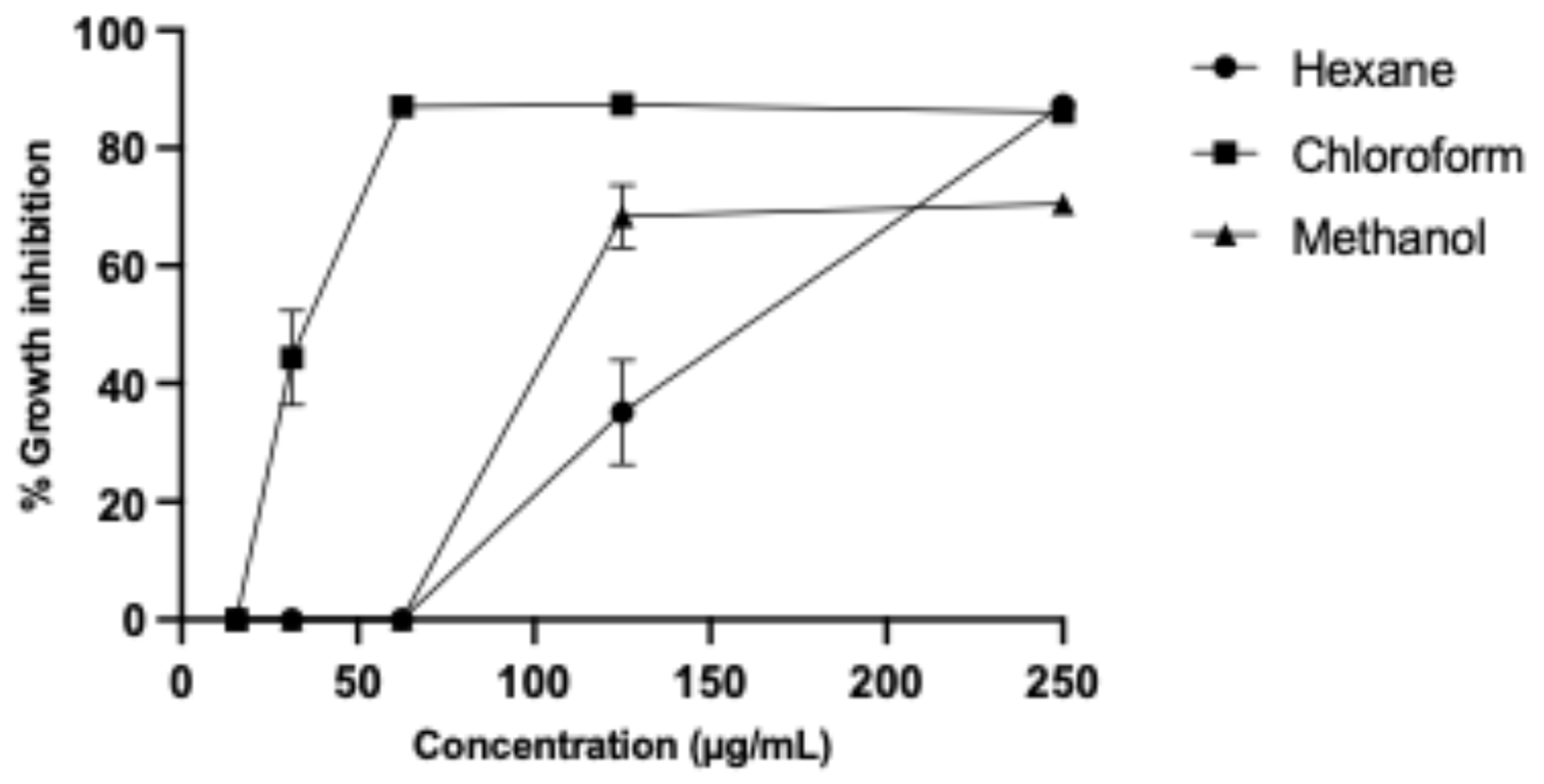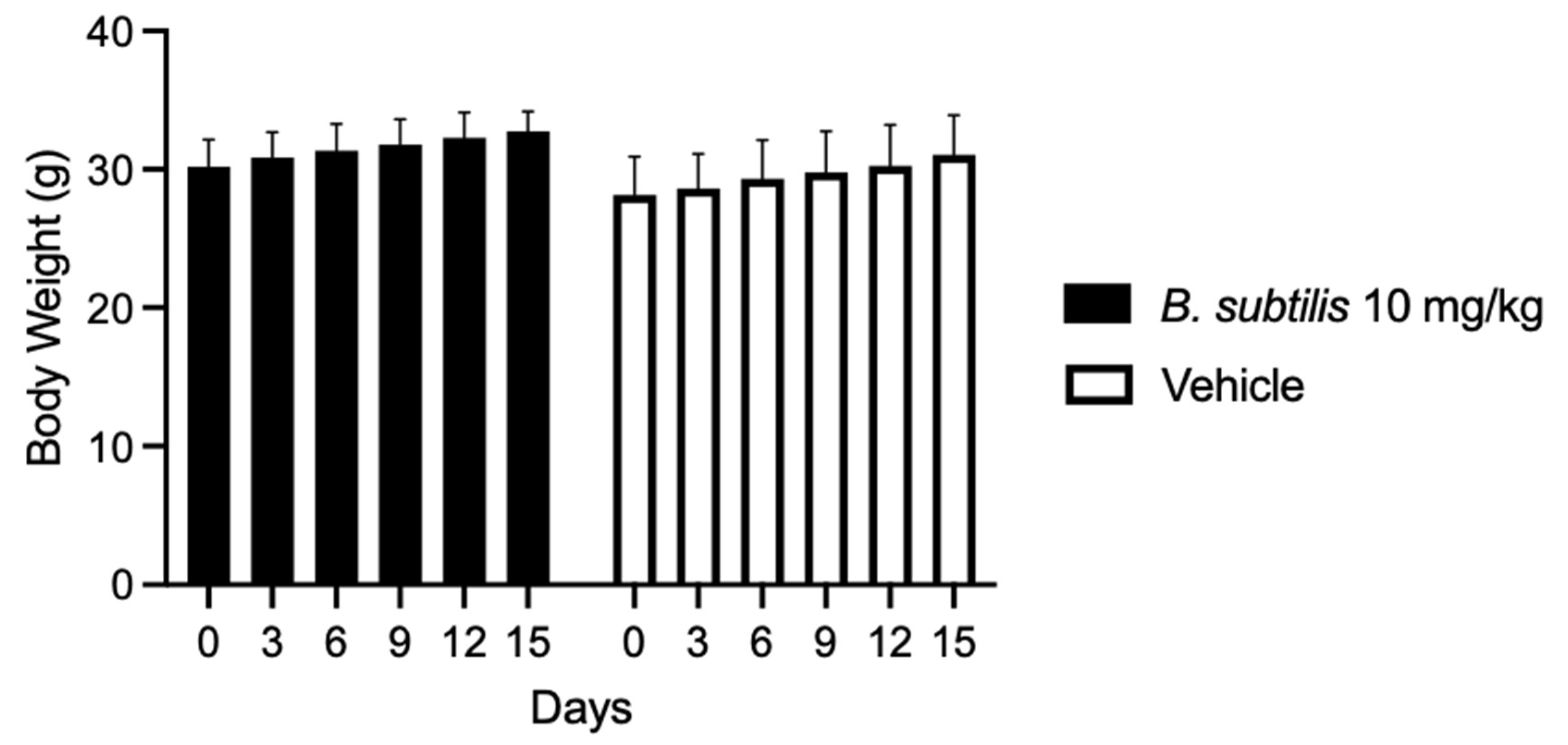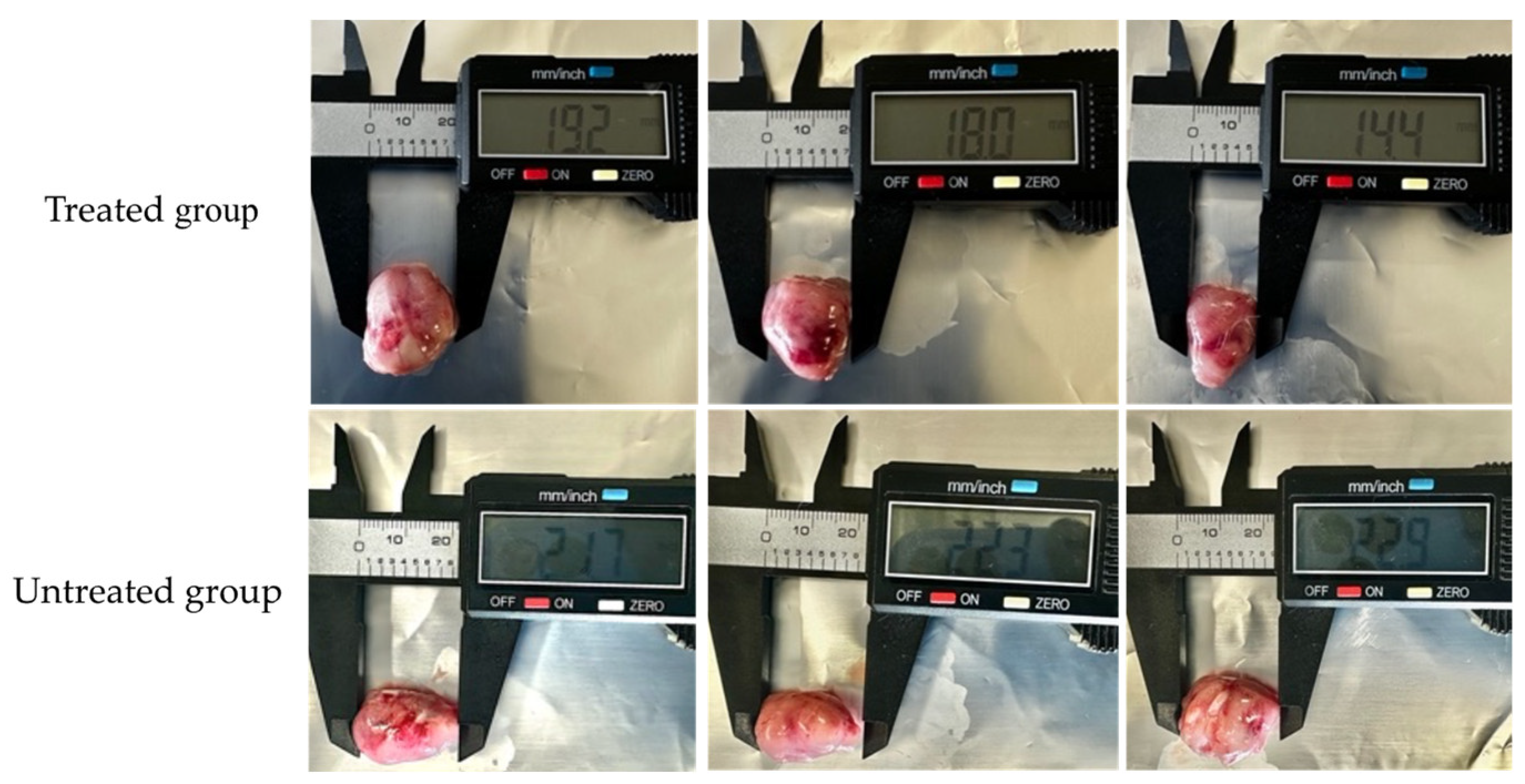In Vitro and In Vivo Antitumor Activity of a Chloroform Partition from Ibervillea sonorae (S. Watson) Greene Endophytic Bacillus subtilis Extracts
Abstract
1. Introduction
2. Results
2.1. In Vitro Antitumor Activity of B. subtilis Extracts Against L5178Y-R Cells
2.2. Biological Activity of B. subtilis Extracts
2.3. Phytochemical Analysis of B. subtilis Extract
2.4. Maximum Tolerated Dose of B. subtilis Extract in Tumor-Free Mice
2.5. In Vivo Effect of B. subtilis Extract Against L5178Y-R Cells
3. Discussion
4. Materials and Methods
4.1. Bacillus Strain
4.2. Preparation of Extracts
4.3. Cell Lines
4.4. Effect of Extracts on L5178Y-R Cell Growth
4.5. Antioxidant Activity
4.6. Hemolytic and Anti-Hemolytic Activity
4.7. Phytochemical Analysis of the Extract
4.8. Animals
4.9. Maximum Tolerated Dose Test
4.10. In Vivo Antitumor Activity
4.11. Statistical Analysis
5. Conclusions
Author Contributions
Funding
Data Availability Statement
Acknowledgments
Conflicts of Interest
Correction Statement
References
- Stewart, B.W.; Kleihues, P. (Eds.) World Cancer Report; IARC Publications: Lyon, France, 2003. [Google Scholar]
- Bray, F.; Ferlay, J.; Soerjomataram, I.; Siegel, R.L.; Torre, L.A.; Jemal, A. Global cancer statistics 2018: GLOBOCAN estimates of incidence and mortality worldwide for 36 cancers in 185 countries. CA A Cancer J. Clin. 2018, 68, 394–424. [Google Scholar] [CrossRef]
- Molyneux, E.M.; Rochford, R.; Griffin, B.; Newton, R.; Jackson, G.; Menon, G.; Harrison, C.J.; Israels, T.; Bailey, S. Burkitt’s lymphoma. Lancet 2012, 379, 1234–1244. [Google Scholar] [CrossRef]
- Jemal, A.; Bray, F.; Center, M.M.; Ferlay, J.; Ward, E.; Forman, D. Global cancer statistics. CA A Cancer J. Clin. 2011, 61, 69–90. [Google Scholar] [CrossRef]
- Cavalcanti, I.D.L.; Soares, J.C.S.; Cavalcanti, I.D.L.; Soares, J.C.S. Conventional cancer treatment. In Advances in Cancer Treatment: From Systemic Chemotherapy to Targeted Therapy; Springer Nature: Berlin/Heidelberg, Germany, 2021; pp. 29–56. [Google Scholar]
- Singh, A.; Singh, D.K.; Kharwar, R.N.; White, J.F.; Gond, S.K. Fungal endophytes as efficient sources of plant-derived bioactive compounds and their prospective applications in natural product drug discovery: Insights, avenues, and challenges. Microorganisms 2021, 9, 197. [Google Scholar] [CrossRef]
- Raimi, A.; Adeleke, R. Bioprospecting of endophytic microorganisms for bioactive compounds of therapeutic importance. Arch. Microbiol. 2021, 203, 1917–1942. [Google Scholar] [CrossRef]
- Numan, M.; Shah, M.; Asaf, S.; Ur Rehman, N.; Al-Harrasi, A. Bioactive compounds from endophytic bacteria Bacillus subtilis strain EP1 with their antibacterial activities. Metabolites 2022, 12, 1228. [Google Scholar] [CrossRef]
- Romero-Arguelles, R.; Romo-Sáenz, C.I.; Morán-Santibáñez, K.; Tamez-Guerra, P.; Quintanilla-Licea, R.; Orozco-Flores, A.A.; Gomez-Flores, R. In vitro antitumor activity of endophytic and rhizosphere gram-positive bacteria from Ibervillea sonidoe (S. Watson) Greene against L5178Y-R lymphoma cells. Int. J. Environ. Res. Public Health 2022, 19, 894. [Google Scholar] [CrossRef]
- Hedrich, H. (Ed.) The Laboratory Mouse; Academic Press: Cambridge, MA, USA, 2004. [Google Scholar]
- Sung, H.; Ferlay, J.; Siegel, R.L.; Laversanne, M.; Soerjomataram, I.; Jemal, A.; Bray, F. Global cancer statistics 2020: GLOBOCAN estimates of incidence and mortality worldwide for 36 cancers in 185 countries. CA A Cancer J. Clin. 2021, 71, 209–249. [Google Scholar] [CrossRef]
- Raguz, S.; Yagüe, E. Resistance to chemotherapy: New treatments and novel insights into an old problem. Br. J. Cancer 2008, 99, 387–391. [Google Scholar] [CrossRef]
- Zheng, L.P.; Zou, T.; Ma, Y.J.; Wang, J.W.; Zhang, Y.Q. Antioxidant and DNA damage protecting activity of exopolysaccharides from the endophytic bacterium Bacillus Cereus SZ1. Molecules 2016, 21, 174. [Google Scholar] [CrossRef]
- Ghosh, A.; Sutradhar, S.; Baishya, D. Delineating thermophilic xylanase from Bacillus licheniformis DM5 towards its potential application in xylooligosaccharides production. World J. Microbiol. Biotechnol. 2019, 35, 34. [Google Scholar] [CrossRef]
- Nafie, M.S.; Awad, N.M.; Tag, H.M.; Abd El-Salam, I.M.; Diab, M.K.; El-Shatoury, S.A. Micromonospora species from rarely-exploited Egyptian habitats: Chemical profile, antimicrobial, and antitumor activities through antioxidant properties. Appl. Microbiol. Biotechnol. 2021, 105, 2427–2439. [Google Scholar] [CrossRef]
- Ek-Ramos, M.J.; Gomez-Flores, R.; Orozco-Flores, A.A.; Rodríguez-Padilla, C.; González-Ochoa, G.; Tamez-Guerra, P. Bioactive products from plant-endophytic Gram-positive bacteria. Front. Microbiol. 2019, 10, 463. [Google Scholar] [CrossRef]
- Alarcon-Aguilar, F.J.; Calzada-Bermejo, F.; Hernandez-Galicia, E.; Ruiz-Angeles, C.; Roman-Ramos, R. Acute and chronic hypoglycemic effect of Ibervillea sonidoe root extracts-II. J. Ethnopharmacol. 2005, 97, 447–452. [Google Scholar] [CrossRef]
- Torres-Moreno, H.; Marcotullio, M.C.; Velázquez, C.; Ianni, F.; Garibay-Escobar, A.; Robles-Zepeda, R.E. Cucurbitacin IIb, a steroidal triterpene from Ibervillea sonidoe induces antiproliferative and apoptotic effects on cervical and lung cancer cells. Steroids 2020, 157, 108597. [Google Scholar] [CrossRef]
- Vidal-Gutiérrez, M.; Torres-Moreno, H.; Hernández-Gutiérrez, S.; Velazquez, C.; Robles-Zepeda, R.E.; Vilegas, W. Antiproliferative activity of standardized phytopreparations from Ibervillea sonidoe (S. Watson) Greene. Steroids 2021, 169, 108824. [Google Scholar] [CrossRef]
- Torres-Moreno, H.; Velázquez, C.A.; Garibay-Escobar, A.; Curini, M.; Marcotullio, M.C.; Robles-Zepeda, R.E. Antiproliferative induction and apoptosis of cucurbitacin-type triterpenes from Ibervillea sonorae. Crops Ind. Prod. 2015, 77, 895–900. [Google Scholar] [CrossRef]
- Karanam, G.; Arumugam, M.K.; Sirpu Natesh, N. Anticancer effect of marine sponge-associated Bacillus pumilus AMK1 derived dipeptide Cyclo (-Pro-Tyr) in human liver cancer cell line through apoptosis and G2/M phase arrest. Int. J. Pept. Res. Ther. 2020, 26, 445–457. [Google Scholar] [CrossRef]
- Molina, M.A.F.; Gamboa, E.M.; Calderon, M.E.R.; Benavides, P.Z.; Morales, L.G.R.; Monsivais, L.Z.; Cerda, E.E.C.N.; Rivera, C.A.S.; Guerra, R.T.; Padilla, C.R.I.G. In vitro antitumor activity of soluble protein extracts from Bacillus thuringiensis. Afr. J. Microbiol. Res. 2016, 10, 324–329. [Google Scholar] [CrossRef]
- Nighat, F.; Mushtaq, Z.; Maqsood, M.; Shahid, M.; Hanif, M.A.; Jamil, A. Cytotoxic, a-amylase inhibitory and thrombolytic activities of organic and aqueous extracts of Bacillus clausii KP10. Pak. J. Pharm. Sci. 2020, 33, 135. [Google Scholar]
- Dey, G.; Bharti, R.; Banerjee, I.; Das, A.K.; Das, C.K.; Das, S.; Jena, B.C.; Misra, M.; Sen, R.; Mandal, M. Pre-clinical risk assessment and therapeutic potential of antitumor lipopeptide ‘Iturin A’ in an in vivo and in vitro model. RSC Adv. 2016, 6, 71612–71623. [Google Scholar] [CrossRef]
- Ma, E.L.; Choi, Y.J.; Choi, J.; Pothoulakis, C.; Rhee, S.H.; Im, E. The anticancer effect of probiotic Bacillus polyfermenticus on human colon cancer cells is mediated through ErbB2 and ErbB3 inhibition. Int. J. Cancer 2010, 127, 780–790. [Google Scholar] [CrossRef] [PubMed]
- Zhao, H.; Yan, L.; Guo, L.; Sun, H.; Huang, Q.; Shao, D.; Jiang, C.; Shi, J. Effects of Bacillus subtilis iturin A on HepG2 cells in vitro and vivo. AMB Express 2021, 11, 67. [Google Scholar] [CrossRef] [PubMed]
- Prihanto, A.A.; Firdaus, M.; Nurdiani, R. Endophytic Fungi Isolated from Mangrove (Rhyzopora mucronata) and Its Antibacterial Activity on Staphylococcus aureus and Escherichia coli. J. Food Sci. Eng. 2011, 1, 386–389. [Google Scholar]
- Mosmann, T. Rapid Colorimetric Assay for Cellular Growth and Survival: Application to Proliferation and Cytotoxicity Assays. J. Immunol. Methods 1983, 65, 55–63. [Google Scholar] [CrossRef]
- Ramírez-Villalobos, J.M.; Romo-Sáenz, C.I.; Morán-Santibañez, K.S.; Tamez-Guerra, P.; Quintanilla-Licea, R.; Orozco-Flores, A.A.; Romero-Arguelles, R.; Tamez-Guerra, R.; Rodríguez-Padilla, C.; Gomez-Flores, R. In vitro tumor cell growth inhibition induced by Lophocereus marginatus (Dc.) S. Arias and Terrazas endophytic fungi extracts. Int. J. Environ. Public Health Res. 2021, 18, 9917. [Google Scholar] [CrossRef]
- Kačániová, M.; Vukovic, N.L.; Čmiková, N.; Bianchi, A.; Garzoli, S.; Ben Saad, R.; Ben Hsouna, A.; Elizondo-Luévano, J.H.; Ahl, H.A.H.S.-A.; Hikal, W.M.; et al. Biological activity and phytochemical characteristics of star anise (Illicium verum) essential oil and its anti-Salmonella activity on sous vide pumpkin model. Foods 2024, 13, 1505. [Google Scholar] [CrossRef]
- Elizondo-Luévano, J.H.; Castro-Ríos, R.; Vicente, B.; Fernández-Soto, P.; López-Aban, J.; Antonio, M.U.R.O.; Chávez-Montes, A. In vitro antischistosomal activity of the Argemone Mexicana methanolic extract and its main component berberine. Iran. J. Parasitol. 2021, 16, 91. [Google Scholar] [CrossRef]
- Rodríguez-Garza, N.E.; Quintanilla-Licea, R.; Romo-Sáenz, C.I.; Elizondo-Luevano, J.H.; Tamez-Guerra, P.; Rodríguez-Padilla, C.; Gomez-Flores, R. In Vitro Biological Activity and Lymphoma Cell Growth Inhibition by Selected Mexican Medicinal Plants. Life 2023, 13, 958. [Google Scholar] [CrossRef]
- Workman, P.; Aboagye, E.O.; Balkwill, F.; Balmain, A.; Bruder, G.; Chaplin, D.J.; Double, J.A.; Everitt, J.; Farningham, D.A.H.; Glennie, M.J.; et al. Guidelines for the welfare and use of animals in cancer research. Br. J. Cancer 2010, 102, 1555–1577. [Google Scholar] [CrossRef]
- Clark-Pérez, D.L.; Romo-Sáenz, C.I.; Ramírez-Villalobos, J.M.; Tamez-Guerra, P.; Caballero-Hernández, D.; Delgado-Miranda, A.L.; García, A.; Gomez-Flores, R. In Vitro and In Vivo Antitumor Activity of Lophocereus marginatus (DC.) S. Arias & Terrazas Endophytic Aspergillus versicolor and Metarhizium anisopliae Extracts Against the Murine Lymphoma L5178Y-R. Microorganisms 2024, 12, 2310. [Google Scholar] [CrossRef] [PubMed]
- Matias, M.; Silvestre, S.; Falcao, A.; Alves, G. Considerations and Pitfalls in Selecting the Drug Vehicles for Evaluation of New Drug Candidates: Focus on in Vivo Pharmaco-Toxicological Assays Based on the Rotarod Performance Test. J. Pharm. Pharm. Sci. 2018, 21, 110–118. [Google Scholar] [CrossRef] [PubMed]
- Gomez-Flores, R.; Quintanilla-Licea, R.; Hernandez-Martinez, C.H.; Samaniego-Escamilla, M.; Tamez-Guerra, P.; Monreal-Cuevas, E.; Tamez-Guerra, R.; Rodriguez-Padilla, C. Survival of Lymphoma-Bearing Mice by Pachycereus Marginatus Cactus Extracts and Elucidation of Bioactive Compounds. Nat. Prod. Commun. 2019, 14, 1934578X19845814. [Google Scholar] [CrossRef]




| Partition | Performance | L5178Y-R 1 | PBMC 1 | SI |
|---|---|---|---|---|
| Hexane | 124 mg/g | 148.1 ± 0.330 | >500 ± 0.037 | 3.37 |
| Chloroform | 1187 mg/g | 34.62 ± 0.180 | 537.7 ± 2.731 | 15.53 |
| Methanol | 1011 mg/g | 117.7 ± 0.310 | >500 ± 0.003 | 4.24 |
| Partition | Hemolysis | Anti-Hemolysis (AAPH) | Antioxidant Activity (DPPH) |
|---|---|---|---|
| Hexane | 74.01 ± 0.270 | 606.5 ± 0.440 | 0 |
| Chloroform | 1443 ± 0.490 | 11,847 ± 0.610 | 0 |
| Methanol | 223.2 ± 0.370 | 89.35 ± 0.290 | 0 |
| Classes | Chloroform Partition |
|---|---|
| Triterpenes | ++ 1 |
| Coumarins | +++ |
| Sesquiterpene lactones | - |
| Quinones | - |
| Saponins | - |
| Flavonoids | - |
| Tannins | ++ |
| Carbohydrates | - |
| Alkaloids | +++ |
| Test | Treatment (10 mg/kg) | Reference Values |
|---|---|---|
| Albumin | 3.06 ± 0.05 | 2.0–4.6 g/dL [10] |
| Total proteins | 4.06 ± 0.15 | 4.3–6.4 g/dL [10] |
| Alkaline phosphatase | 174.00 ± 17.34 | 44–118 U/L [10] |
| Aspartate aminotransferase | 159.5 ± 21.92 | 69–191 U/L [10] |
| Alanine transaminase | 46.46 ± 4.05 | 26–120 U/L [10] |
| Total bilirubin | 0.08 ± 0.02 | 0.3–0.8 mg/dL [10] |
| Test | Treated Group (10 mg/kg) | Untreated Group | Vehicle | Negative Control | Reference |
|---|---|---|---|---|---|
| Albumin | 3.36 ± 0.11 | 3.53 ± 0.25 | 3.65 ± 0.05 | 3.10 ± 0.36 | 2.0–4.6 g/dL [10] |
| Total proteins | 4.64 ± 0.15 | 5.26 ± 0.41 | 4.85 ± 0.12 | 4.51 ± 0.66 | 4.3–6.4 g/dL [10] |
| Alkaline phosphatase | 57.40 ± 18.44 | 68.66 ± 30.85 | 127.75 ± 24.12 | 190.22 ± 37.12 | 44–118 U/L [10] |
| Aspartate aminotransferase | 233 ± 24.33 | 307.66 ± 54.04 | 93.33 ± 12.50 | 140.04 ± 56.56 | 69–191 U/L [10] |
| Alanine transaminase | 81.10 ± 17.34 | 69.29 ± 5.79 | 31.73 ± 2.40 | 67.86 ± 37.83 | 26–120 U/L [10] |
| Total bilirubin | 0.08 ± 0.008 | 0.08 ± 0.02 | 0.07 ± 0.005 | 0.05 ± 0.01 | 0.3–0.8 mg/dL [10] |
Disclaimer/Publisher’s Note: The statements, opinions and data contained in all publications are solely those of the individual author(s) and contributor(s) and not of MDPI and/or the editor(s). MDPI and/or the editor(s) disclaim responsibility for any injury to people or property resulting from any ideas, methods, instructions or products referred to in the content. |
© 2025 by the authors. Licensee MDPI, Basel, Switzerland. This article is an open access article distributed under the terms and conditions of the Creative Commons Attribution (CC BY) license (https://creativecommons.org/licenses/by/4.0/).
Share and Cite
Romero-Arguelles, R.; Romo-Sáenz, C.I.; Tamez-Guerra, P.; Fonseca-Rivera, D.; Elizondo-Luevano, J.H.; Rodriguez-Garza, N.E.; Pérez-González, O.; Quiñones-Flores, C.M.; Arzate-Quintana, C.; Hernandez, L.P.L.; et al. In Vitro and In Vivo Antitumor Activity of a Chloroform Partition from Ibervillea sonorae (S. Watson) Greene Endophytic Bacillus subtilis Extracts. Plants 2025, 14, 1474. https://doi.org/10.3390/plants14101474
Romero-Arguelles R, Romo-Sáenz CI, Tamez-Guerra P, Fonseca-Rivera D, Elizondo-Luevano JH, Rodriguez-Garza NE, Pérez-González O, Quiñones-Flores CM, Arzate-Quintana C, Hernandez LPL, et al. In Vitro and In Vivo Antitumor Activity of a Chloroform Partition from Ibervillea sonorae (S. Watson) Greene Endophytic Bacillus subtilis Extracts. Plants. 2025; 14(10):1474. https://doi.org/10.3390/plants14101474
Chicago/Turabian StyleRomero-Arguelles, Ricardo, César Iván Romo-Sáenz, Patricia Tamez-Guerra, Diego Fonseca-Rivera, Joel H. Elizondo-Luevano, Nancy Edith Rodriguez-Garza, Orquidea Pérez-González, Celia María Quiñones-Flores, Carlos Arzate-Quintana, Lydia Paulina Loya Hernandez, and et al. 2025. "In Vitro and In Vivo Antitumor Activity of a Chloroform Partition from Ibervillea sonorae (S. Watson) Greene Endophytic Bacillus subtilis Extracts" Plants 14, no. 10: 1474. https://doi.org/10.3390/plants14101474
APA StyleRomero-Arguelles, R., Romo-Sáenz, C. I., Tamez-Guerra, P., Fonseca-Rivera, D., Elizondo-Luevano, J. H., Rodriguez-Garza, N. E., Pérez-González, O., Quiñones-Flores, C. M., Arzate-Quintana, C., Hernandez, L. P. L., & Gomez-Flores, R. (2025). In Vitro and In Vivo Antitumor Activity of a Chloroform Partition from Ibervillea sonorae (S. Watson) Greene Endophytic Bacillus subtilis Extracts. Plants, 14(10), 1474. https://doi.org/10.3390/plants14101474










